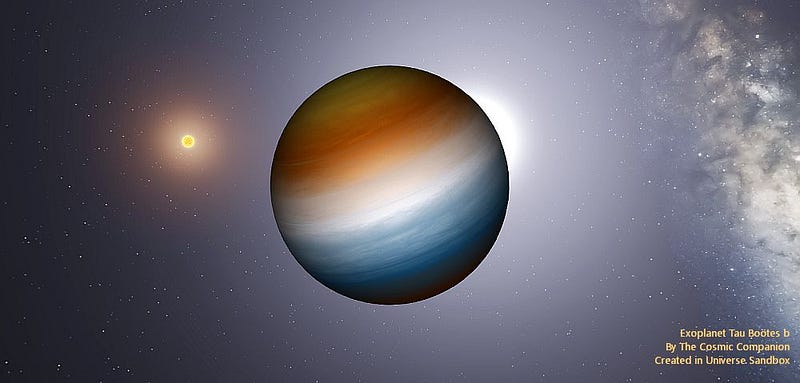Discovering the Magnetic Secrets of Tau Boötis b
Written on
Chapter 1: The Radio Emissions of Tau Boötis b
The exoplanet Tau Boötis b has been detected emitting radio waves, similar to those observed around Jupiter within our solar system. This discovery provides astronomers with their initial evidence of a magnetic field enveloping an exoplanet.

Located far from our planet in the Tau Boötes system, this massive exoplanet circles a binary star system, radiating brightly in radio frequencies. These emissions present the first signs of magnetic fields surrounding planets in other solar systems, potentially offering astronomers a new method to investigate distant worlds scattered across the galaxy.
Recently, astronomers at Cornell University observed radio waves coming from this distant planet, marking a historic first for detecting such emissions from an exoplanet beyond our Solar System. According to Jake D. Turner, a postdoctoral researcher at Cornell University, "The signal originates from the Tau Boötes system, which includes a binary star and a planet. We argue that the emission is produced by the planet itself. The strength and polarization of the radio signal, along with the planet’s magnetic field, align with theoretical predictions."
Join us for a discussion on Astronomy News with The Cosmic Companion on January 5, 2021, featuring Dr. Jake Turner from Cornell University, as we delve into this intriguing study.
Section 1.1: LOFAR's Role in Exoplanet Research
The Low Frequency Array (LOFAR), a unique network of radio telescopes in the Netherlands, played a critical role in this research. LOFAR is the largest telescope capable of detecting astronomical phenomena at the lowest frequencies observable from Earth.
The team utilized LOFAR to investigate various exoplanets in our galactic vicinity. Their targets included a hot Jupiter—an enormous exoplanet orbiting perilously close to its sun—as well as planets located in the constellations Cancer and Andromeda. They began their investigation by studying radio emissions from Jupiter, modeling these signals to predict how a similar signal from another star system would appear from our perspective.
Using this model, researchers focused their search on three planetary systems situated 40 to 100 light years from Earth. After approximately 100 hours of observations, they detected radio emissions from a planet in the Tau Boötes system, located 51 light years away.
The Tau Boötes system comprises a pair of stars: a young, hot F-type star and a cooler red dwarf, accompanied by a massive hot Jupiter that completes an orbit around the binary stars every 80 hours.
The first video titled "Radio Emissions Detected From Planet Tau Boötis b - But What Caused It?" explores the origins of the radio waves detected and their implications for understanding exoplanetary magnetic fields.
Section 1.2: Insights into Magnetic Fields
This discovery—the initial indication of a magnetic field around an exoplanet—could significantly enhance researchers' capabilities to examine such distant worlds. Charged particles in the solar wind from our sun interact with Earth's magnetic field, leading to changes in velocity that can produce peculiar signals in radio data.
Researchers hypothesize that the radio signal detected from Tau Boötis b may arise from protons and electrons being influenced by the planet's magnetic field, estimated to range between five to 11 Gauss, akin to Jupiter's magnetic strength. However, the signal weakens by the time it reaches Earth, leaving uncertainty about its true origin; solar flares could also be the source of these emissions.
Studying radio waves from exoplanets could yield valuable insights into the geology and atmospheres of these far-off worlds. By analyzing the magnetic fields surrounding these planets, researchers may uncover details about the interactions between planets and their host stars.
The second video titled "New Radio Signals from Deep Space and a New Exoplanet" discusses the implications of these findings and the future of radio astronomy in exoplanet research.
A significant hurdle for astronomers attempting to observe radio emissions from exoplanets is the interference from radiation surrounding Earth and the Sun. The ability to detect these emissions heralds a vibrant new research frontier. Observing planetary auroral radio emissions is a promising approach to uncover exoplanetary magnetic fields, which could enhance our understanding of their internal structures, atmospheric losses, and overall habitability.

The magnetic field of Earth shields life from solar radiation, and researchers speculate that similar fields around exoplanets may also protect potential life on those worlds. Turner notes, "The magnetic fields of Earth-like exoplanets may play a crucial role in their habitability by protecting their atmospheres from solar winds and cosmic rays, thereby preventing atmospheric loss."
Future studies will focus on Tau Boötis b and other similar targets, providing astronomers with new tools to deepen our understanding of these distant celestial bodies. James Maynard is the founder and publisher of The Cosmic Companion, residing in Tucson with his wife Nicole and their cat, Max.
Did you enjoy this article? Join us on The Cosmic Companion Network for our podcast, weekly video series, informative newsletter, and news briefings on Amazon Alexa and more!